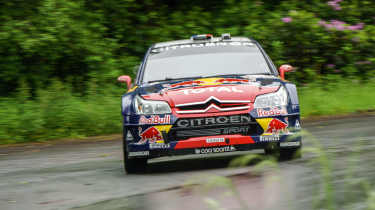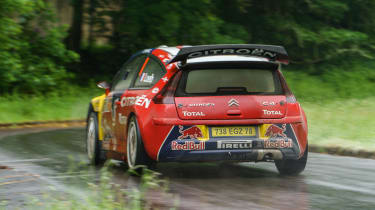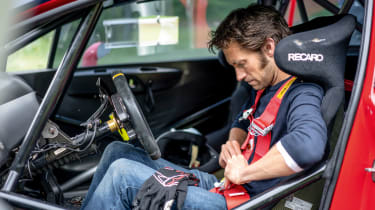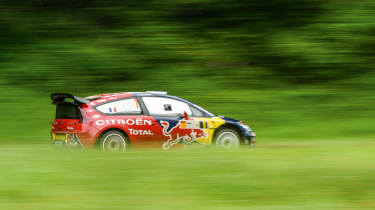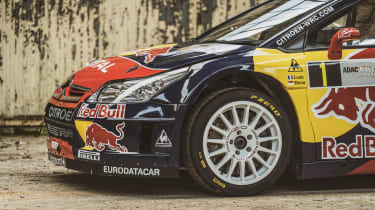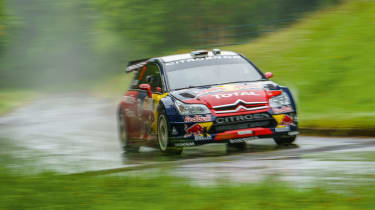Citroën C4 WRC drive – behind the wheel of a rally icon
The C4 WRC is one of the greatest rally cars of all time, and this example was driven by the most successful rally driver of all. Now it’s our turn to get behind the wheel
We’re airborne. a familiar weightless serenity has pervaded the cockpit. Earth’s surly bonds have been slipped.
We’re still airborne.
In fact we’re airborne for so long that I half expect to hear the bing bong of a tannoy interrupt the semi-silence: ‘Welcome to Citroën Airways. Please ensure your seatbelts are fastened as we prepare for landing. Doors to manual and cross check.’
Then ground meets tyres. Springs and spines compress. The cacophony recommences. Left foot hits brake pedal. The car darts into a left-hander, which then tightens into a hairpin. An almost lazy pull on the big handbrake. Calm again for a moment as the car rotates with the rear wheels frozen… then an anti-lag-primed punch of acceleration slams the C4 WRC forward.
> Best Impreza Colin McRae Edition review – homage to McRae's championship 555 racer
That was 13 years ago, in France. I was a passenger in the co-driver’s seat, watching none other than Sébastien Loeb do his thing. The swift, sure inputs. The astonishing speed carried in corners. The experience of a lifetime.
And now I’m standing at Monet’s easel. The paints and brushes are at my disposal…
This particular C4 is from 2008, the year I rode with Loeb, but it’s not the same car. That was a test car, whereas this is chassis 14, which won no fewer than four rallies with Loeb and Daniel Elena onboard. The first of those victories was Monte Carlo, the car winning fresh out of the box, wearing a relatively plain red livery. Next up it was the hot gravel of Sardinia, then back onto the sealed surface of Rally Deutschland – the spec that it’s in today – before conquering the mud of Wales Rally GB. It even went on to be used by another world champion in 2010; Kimi Räikkönen rolled it down a hill on SS7 of Rally Mexico.
More reviews
Group tests
- Alpine A290 v Alpine A110 – how much DNA do they really share?
- Ariel Atom 4R v Caterham Seven ‘evo25’: power-to-weight heroes go head-to-head
- Aston Martin Vantage vs Audi R8 V10 RWD – back to basics
- Caterham Super Seven 600 v Super Seven 2000
- Levante v T1
- Corvette Stingray v Porsche Cayman GTS v Audi R8 RWD
- Great Ferrari hypercars driven: 288 GTO, F40, F50 and Enzo head-to-head
- Hardcore Ferrari V8 specials go head-to-head
- Lamborghini Aventador Ultimae v Lamborghini Countach
- Lotus Emira v Morgan Plus Four – four-cylinder Brits go head-to-head
In-depth reviews
- Abarth 600e 2025 review – Italy gives the Alpine A290 something to worry about
- Alpine A110 review – distinctive, lightweight and unforgettable to drive
- Audi RS7 Sportback Performance review
- Bentley Continental R Mulliner: review, history and specs
- BMW 5-series review – is this still Munich’s anchor model?
- BMW 1-series review – Munich’s Audi A3 rival gains focus
Long term tests
- Abarth 695C Turismo Fast Fleet test – 10,000 miles in the Italian hot hatch
- Alfa Romeo Giulia Veloce Fast Fleet test – 7000 miles in the sharp Italian saloon
- Alpina B10: end of term report
- Alpina B10
- Ford Mustang GT
- Ford Mustang GT
- Ford Mustang GT
- Land Rover Defender 110 Fast Fleet test – 9000 miles in the go-anywhere SUV
- Maserati Ghibli Trofeo Fast Fleet test – 4000 miles in the Ferrari-powered saloon
- Mitsubishi Evo MR 340
Review
- New Aston Martin DBS 770 Ultimate review – 759bhp super-GT driven
- New Bentley Batur 2023 review – can it possibly be worth £1.65m?
- 2023 Chevrolet Corvette C8 Z06 review – the American 911 GT3?
- Kia EV6 GT-Line S prototype review – the EV that shows how it’s done
- BBR Supercharged Mazda MX-5 (ND) 2023 review – tuned 250bhp roadster driven
- MG4 Trophy 2023 review
Reviews
- Abarth 695 75 Anniversario edition 2024 review – a fitting send-off for Abarth’s hot supermini?
- Abarth 500e 2023 review
- AC Cobra 378 Superblower MkIV 2021 review – another V8 Cobra, but with a GM heart this time
- Acura Integra Type S 2024 review – a Honda Civic Type R with added restraint
- Alfa Romeo Giulia 2025 review – get one while you still can
- Alfa Romeo SZ: history, review and specs of an icon
- Alfa Romeo 1750 TBi
- Alpina B3 GT Touring 2025 review – a 190mph alternative to the BMW M3 Touring
‘I’d like to have had it in Monte livery,’ says the ever-smiley, ever-suave Max Girardo, the car’s new owner, ‘but the Red Bull livery that came in half way through the 2008 season is just so much cooler. It’s the one.’
And despite competing on both gravel and tarmac rallies, the C4 really belongs in hunkered-down, big-wheel, big-brake spec. Citroën developed its rally cars as tarmac cars first and then adapted them to work on gravel and it showed in the results. The car was good on gravel, but in the hands of Loeb it was literally unbeatable on asphalt. Over the C4’s four-season lifespan between 2007 and 2010 it won every sealed surface WRC round. Few cars in motorsport have been so dominant.
Today, sheltering from the rain in a barn, it looks better than ever. It’s such a neat, clean, aerodynamic shape. Yes there is the big rear wing, but compared with many WRC cars it is remarkably unadorned. Where with the current generation you have to look for the original road car as you would a friend at a fancy dress party, this appears almost showroom spec by comparison. Until you open the door.
Inside, you’re presented with a pair of seats set almost comically far back from the dash, right in the middle of the car. Slide between the roll cage and the steering column and your bottom sinks into a very snug Recaro. It’s dark inside, a deep sunstrip covering the top half of the windscreen, the mirror-tinted windows dimming out a good proportion of the light from the sides. Ahead of you is a steering wheel, conventionally round in shape but festooned with brightly coloured buttons and switches, like a prototype for a modern Ferrari road car. Behind it, arcing round from 1 o’clock to 5 o’clock is a single carbon paddle for changing gear. Flick it away with the back of your right hand to change down, tap it towards you to change up. Simple. If you need the handbrake, then it’s conveniently placed and easily spotted thanks to fluorescent yellow tape.
The dash is surprisingly empty. There is just one small screen, about the size of a pack of playing cards, capable of displaying the gear you’re in, some shift lights and a warning light. The rest of the information appears on a screen down on the transmission tunnel, angled towards the co-driver’s seat. There’s also a small forest of switches, which take a little longer to decipher than usual as my French is un peu rouillé.
Most of them won’t be required today, but to start the car I need to flick the one with the white guard to turn the electrics on and wake up the main screen, which cycles through a Windows home page and a GEMS logo before settling on page one of 15 information layouts. Daniel Elena really was like a high-speed office manager. Only once it’s live can I flick the contact switch. Then it’s roughly a five-second wait before I can press the small red button to the left to spin the starter motor.
All this flicking and waiting somehow exaggerates not only the anticipatory silence but the way in which the peace and quiet is then shattered violently by the 2-litre four-pot exploding into life. Rouse a road car, say a raucous hot hatch, and you will be aware that there is noise coming from the engine in front and the exhaust behind, but with relative tranquillity in between. Wake the C4 WRC, however, and the whole car seems to buzz, clatter and growl from bumper to bumper. It feels alive and angry, the revs hunting up and down, searching for some mechanical solace. Bolted solidly to the floor in the Recaro, the vibrations and noise gather you up and envelop you inside this small, localised storm that has broken out. Combined with your own tingling spine and raised heart-rate, it is quite the experience, particularly if you know you are about to try to tame it.
Putting on a helmet damps out some of the noise. Lets you focus. Normally there would be a squeak as the intercom was plugged in and then the reassuring voice of a co-driver to bring some calm, but today it’s just me. Max leans in through the driver’s door and gives me a beaming smile, telling me just to enjoy it and make good use of both the stage mode (labelled Fresh Air in reference to the anti-lag) and the handbrake.
Dip the small but resistant clutch pedal then press the pimple on the back of the paddle and pull it towards you to select first gear with an audible and palpable clunk. It’s stall avoidance time. Experience tells me that any pressure on the throttle will provoke enough noise to make me think I’m buzzing the red line when in fact I’m barely flickering above tickover. So, more throttle and noise than you think, and then try to keep the revs up in the crucial millimetres of travel as the clutch bites. We’re off and now the footwork flits to arcade mode as you switch your left foot to the big brake pedal.
Did I mention that it’s wet today? The OZs are shod with rallying’s equivalent of slicks, and as I plunge beneath the trees for the first time there is trepidation as I turn into the first apex. We’re at a private test venue in deepest Wales, using the old access roads of a disused military facility. It is very definitely not a circuit, so there are sodden leaves and changes of surface and kerb stones. Not red-and-white-striped kerbs, but proper, damage-your-wheels-and-possibly-suspension kerb stones. It’s doing a good imitation of a rally stage.
Accelerating out of the bottom corner, the combination of 430lb ft of torque and short gearing means the wheels spin up even in a straight line as you keep pulling the gears. The C4 remains surprisingly stable and straight, but you can feel it scrabbling. Things only settle down as you go from fourth to fifth and instigate a noticeably bigger drop in the revs. But then it’s back on the brakes, batting away the downshifts and getting everything slowed for the tight double right. You quickly realise that it’s a car you need to drive on the torque and therefore attack each corner a gear higher than you might initially think. Just occasionally you’re actually a gear higher than you want as the paddle is incredibly light and sensitive, so it’s easy to knock it twice unintentionally.
The suspension is firm for a rally car, with remarkably little roll. It is flat and focused, like a touring car converted for the stages. Even in the first few miles, as I’m finding my feet and trying to get some heat into the tyres, the grip that the C4 can generate is astonishing. By the third time of asking I’m already flat in fifth through a fast, blind right-hander over some copper-coloured leaves, the C4 just twitching slightly before the tarmac narrows to barely a car’s width, the green blur in the side windows suddenly getting closer.
Then it’s hard on the big brake pedal again, though judging the pressure to exert is tricky in these conditions. It’s the same with the lateral grip in the slower corners – the limit seems to arrive abruptly and the steering really doesn’t give much feel of how hard the tyres are working. So, partly because it’s a Loeb trait and partly because it feels necessary, I give the belts a tightening tug to squeeze me even more securely into the seat, make me an even more integral part of the car. If the steering isn’t going to provide huge amounts of feedback then I want to feel hardwired into the C4’s slightest shimmy.
The prevailing balance seems to be a touch of understeer at the limit, which is probably the more comforting option at this stage. This was an era when WRC cars could have an active centre diff: the top right manettino-type switch on the steering wheel lets you adjust it a certain amount and after a bit of a play I decide that 4 (out of 5) feels the most natural somehow.
It’s a car that you really need to spend time with though. You need to understand the engineering underneath, as that dictates how it wants to be driven. And you need to know its limits almost instinctively rather than feeling for them. After a few miles I begin to experiment with the handbrake and that opens up a whole new world in the tighter bends. It’s surprisingly easy to get comfortable with rotating the car on the bar, but far from feeling flamboyant there is instead a satisfying sense of extreme efficiency when you get it right. Just as you would in a front-wheel-drive car, you want to use a bit of momentum and then hang on the handbrake, letting the locked rear wheels do all the rotation early in the bend. You need to get the car turned in this way, because as soon as you release the fly-off and get back on the throttle you’ll feel the four-wheel drive pulling you straight rather than exaggerating the slide, launching you purposefully out of the corner with tremendous traction. If you get it right (which just occasionally I do) there shouldn’t be any corrective lock required.
The more I commit to the corners and revel in the speed, the more I realise that in many ways it’s a car that embodies the Sébastien Loeb style of driving: straight. It is the most serious, most tied-down and just plain ruthlessly fast rally car I have ever driven. Most have had a slight looseness to them, a bit more travel, a bit more leeway in their handling. The C4 feels laser-guided by comparison.
As luck would have it, I also got to experience it in the dry a few weeks later at the Goodwood Festival of Speed. The handbrake turn at the bottom of the hill went well, the start was a bit below average and then it was almost serene in the way it just devoured the hill. The grip that it generates in the dry is almost otherworldly. I could feel some heat come into the tyres by about halfway up and I’m certain I’ve never attacked the right-left past the flint wall with so much confidence.
And in the days after that I couldn’t help imagining what this immensely impressive car would be like to drive in a real rally. Because of its precision, it’s a car you could dissect a stage with. And yet to really drive it on the limit over the Col de Turini, to maximise its aggressive grip through the vineyards of Germany, well, that wouldn’t be so easy. Even those two 2008 passenger laps of a test venue seem even more remarkable now I’ve driven the car. The C4 WRC is absolutely amazing, but what Loeb did with it remains more so.
Citroën C4 WRC specs
| Engine | In-line 4-cyl, 1998cc, turbocharged |
| Power | 315bhp @ 5500rpm |
| Torque | 430lb ft @ 2750rpm |
| Weight | 1230kg |
| Power-to-weight | 260bhp/ton |
| 0-62mph | n/a |
| Top speed | n/a |
Thanks to Girardo & Co. Find them on Instagram.
This story was first featured in evo issue 289. To purchase any back issues, or subscribe visit our online shop here

